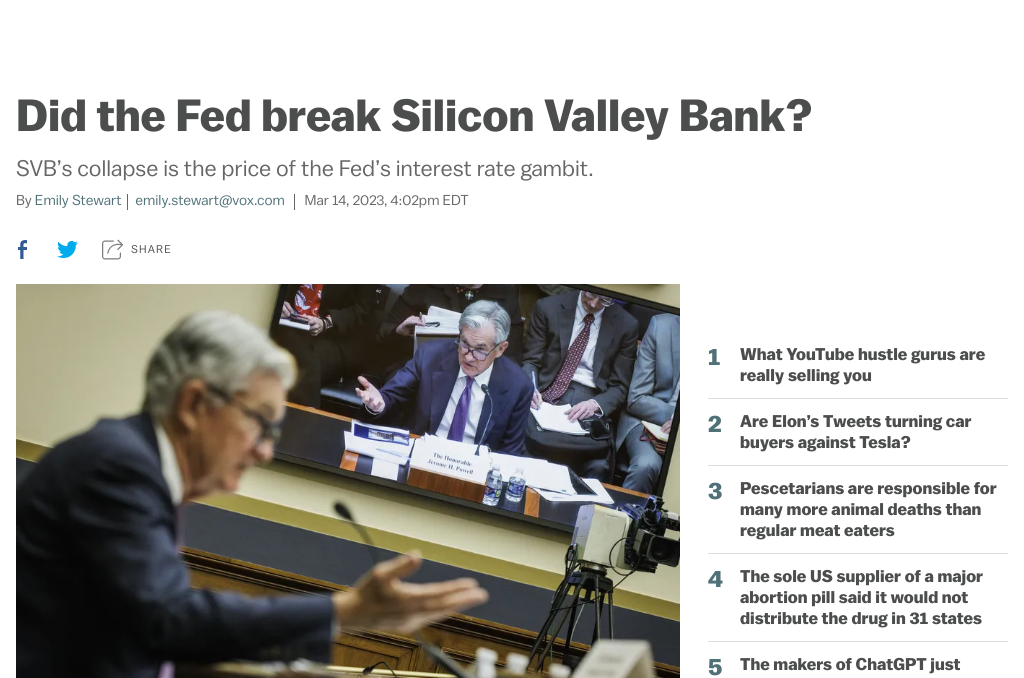On March 13th, 2023, Silicon Valley Bank (SVB) became the second-largest U.S. bank failure in history when it collapsed in less than two days.[0] The bank, which specialized in financing tech startups, was hit by a bank run after signs of trouble at the bank began to emerge in the second week of March.
The trouble began when the Federal Reserve increased interest rates, causing the bonds in which SVB had invested to become worth less.[1] This would normally not be a problem, as the bank could simply wait for those bonds to mature. However, due to a slowdown in venture capital and tech, deposit inflows slowed, and clients started withdrawing their money.[1] It soon became clear that SVB was in the midst of a cash crunch, causing panic and leading to the bank’s ultimate downfall.[1]
Analysts had seen this coming for SVB in particular, noting the bank’s catastrophic interest-rate problems in January.[2] Additionally, venture capital began drying up, forcing startups to draw down funds held by SVB.[3] This caused the bank to sit on a mountain of unrealized losses in bonds just as the pace of customer withdrawals was escalating.[3]
The SVB situation is a stark reminder of what’s on the line in the Fed’s efforts to combat high prices and the potential interest rate increases have to wreak on the economy. Other banks, especially those focused on serving large depositors above the FDIC limit, could find themselves in a similar position if rate hikes continue to occur quickly.[4]
In the wake of SVB’s collapse, big banks such as Bank of America, Wells Fargo, and Citigroup have experienced an increase in deposits as companies and entrepreneurs have made the flight to perceived safety.[5] Silicon Valley Bridge Bank, the entity that the FDIC created to take over SVB’s assets, has encouraged customers to leave their deposits there and has also stated that new and existing deposits are protected.
It is clear that SVB’s failure is an important lesson to be taken into account when it comes to the risks of banks being too concentrated in one industry and failing to properly manage their assets and deposits. It is also a reminder that the Fed’s attempts to combat high prices and interest rate increases have the power to wreak havoc on the economy.
0. “How Silicon Valley Bank Collapsed in 36 Hours: What Went Wrong” The Wall Street Journal, 15 Mar. 2023, https://www.wsj.com/video/series/news-explainers/how-silicon-valley-bank-collapsed-in-36-hours-what-went-wrong/8DBEB163-0EEE-4CC2-B974-8252039D6C38
1. “Silicon Valley Bank collapse: Is the Federal Reserve to blame?” Vox.com, 14 Mar. 2023, https://www.vox.com/money/2023/3/14/23640065/silicon-valley-bank-collapse-fdic-interest-rates-federal-reserve
2. “We Know Who’s to Blame for the Silicon Valley Bank Failure” The Atlantic, 16 Mar. 2023, https://www.theatlantic.com/ideas/archive/2023/03/svb-collapse-fed-regulation-financial-system-safety/673401
3. “How does a bank collapse in 48 hours? A timeline of the SVB fall” CNN, 13 Mar. 2023, https://www.cnn.com/2023/03/11/business/svb-bank-collapse-explainer-timeline/index.html
4. “March 2023 Newsletter: A Look at Bank Solvency” Lyn Alden, 13 Mar. 2023, https://www.lynalden.com/march-2023-newsletter/
5. “The Silicon Valley Bank fallout is just beginning” The Verge, 15 Mar. 2023, https://www.theverge.com/2023/3/15/23642246/silicon-valley-bank-fallout-thiel-capital-uncertainty-vc
